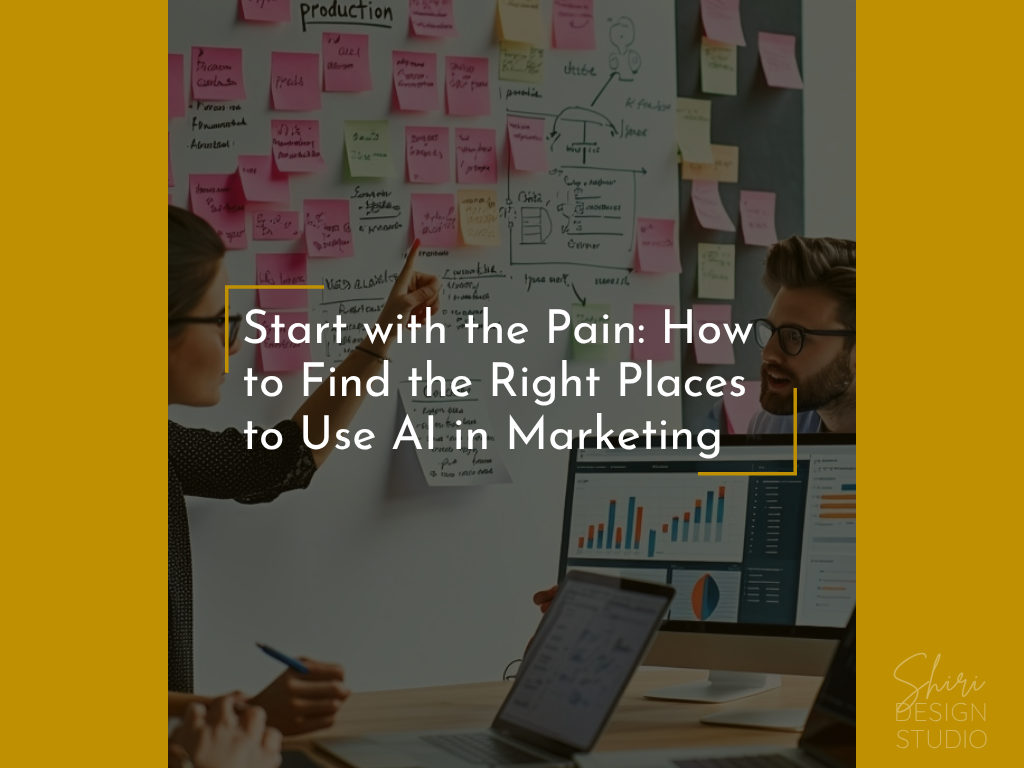Start with the Pain: How to Find the Right Places to Use AI in Your Marketing Team

AI is everywhere right now—and it’s tempting to jump in headfirst. But before you start experimenting with AI tools or revamping your tech stack, pause for a moment. There’s a better starting point:
👉 Start with the pain.
Before you look for AI solutions, take the time to uncover your marketing team’s real pain points. Only then can you find meaningful, efficiency-boosting opportunities to integrate AI in ways that actually solve problems, not just add more tools to manage.
In this post, we’ll walk through how to identify those pain points and how to think about AI as a supportive tool that enhances your existing marketing operations.
Why Pain Points Come First
It’s easy to get caught up in the hype. AI can do everything from generating copy and segmenting audiences to forecasting campaign performance. But just because it can do something doesn’t mean it should—at least not right away.
Jumping into AI without a clear understanding of your current inefficiencies can lead to:
- Tool overload
- Poor adoption
- Wasted budget
- Frustrated teams
Instead, the smartest approach is this: let the pain guide your priorities.
Step 1: Audit Your Marketing Workflows
Start by taking a close look at your marketing operations. Where are the breakdowns happening?
Ask your team:
- What feels slow or repetitive?
- What tasks take up most of your day but don’t move the needle?
- Where are we making avoidable mistakes?
- Which processes stall campaigns or delay launches?
This can include areas like:
- Reporting & analytics
- Content production
- Lead routing & scoring
- Email campaign scheduling
- Customer segmentation
- Social media publishing
Step 2: Group Pain Points by Type
Once you've surfaced pain points, group them into categories. This makes it easier to match them with potential AI tools later.
| Category | Example Pain Point |
|---|---|
| Repetition | Manually tagging leads or updating spreadsheets |
| Speed & Bottlenecks | Waiting for data reports or approvals |
| Scale Challenges | Personalizing emails at scale |
| Lack of Insight | Unclear which campaigns are actually driving results |
| Inconsistency | Inconsistent brand voice across content or channels |
Step 3: Ask: “Could AI Help Here?”
Now that you’ve identified what’s not working, the next step is asking whether AI can solve it—or support it.
Here’s how to frame the question:
“Can AI automate, accelerate, or improve this specific pain point?”
Some examples:
- If reporting takes too long → consider AI-powered dashboards that auto-generate insights.
- If content creation is slow → test AI tools that suggest blog outlines or repurpose long-form content into social posts.
- If lead scoring feels inaccurate → explore AI models that score leads based on real behavioral data.
Remember, the goal is not to replace your team, but to remove friction so they can focus on high-value work.
Step 4: Test AI in One Area First
Instead of launching AI across your whole department, choose one pain point and pilot a tool that targets it.
For example:
- Use AI to summarize weekly analytics reports
- Try a content assistant to brainstorm headlines
- Use an AI chatbot to answer FAQs from MQLs
Track the results. Did it save time? Improve accuracy? Free up your team to be more creative?
Use this pilot to build a case for further adoption—and keep your team involved in evaluating what works.
Step 5: Track Results to Measure Impact
Once you've introduced an AI tool to solve a specific pain point, the next step is tracking how well it’s working. This helps you measure ROI and make data-driven decisions.
- Time saved — Before vs. after comparison
- Output volume — Are you producing more with the same resources?
- Quality & consistency — Fewer errors or improved tone
- Team feedback — Is it actually helping or complicating things?
- Performance metrics — Engagement, conversions, speed to launch
Even a simple before-and-after snapshot can be enough to justify the value of your pilot:
| Metric | Before AI | After AI | Notes |
|---|---|---|---|
| Time to build report | 4 hours | 30 minutes | Used AI-powered analytics summary |
| Blog posts/month | 4 | 7 | Used AI for ideation and outlines |
| Team satisfaction | 3.1/5 | 4.4/5 | Reduced repetitive tasks |
Final Thoughts: Let Problems Drive Your AI Strategy
Too many teams adopt AI for AI’s sake. The real wins happen when you take a pain-first approach:
- 🎯 Find the friction.
- 🧠 Ask the right questions.
- 🔧 Plug in AI where it makes a real difference.
By treating AI as a problem-solving tool—not a shiny object—you’ll create a more efficient, empowered marketing team that’s ready for the future.
Looking for help identifying pain points in your marketing operations?
Let’s chat! We can help you map out your current workflows and pinpoint where AI can save the most time and effort.
